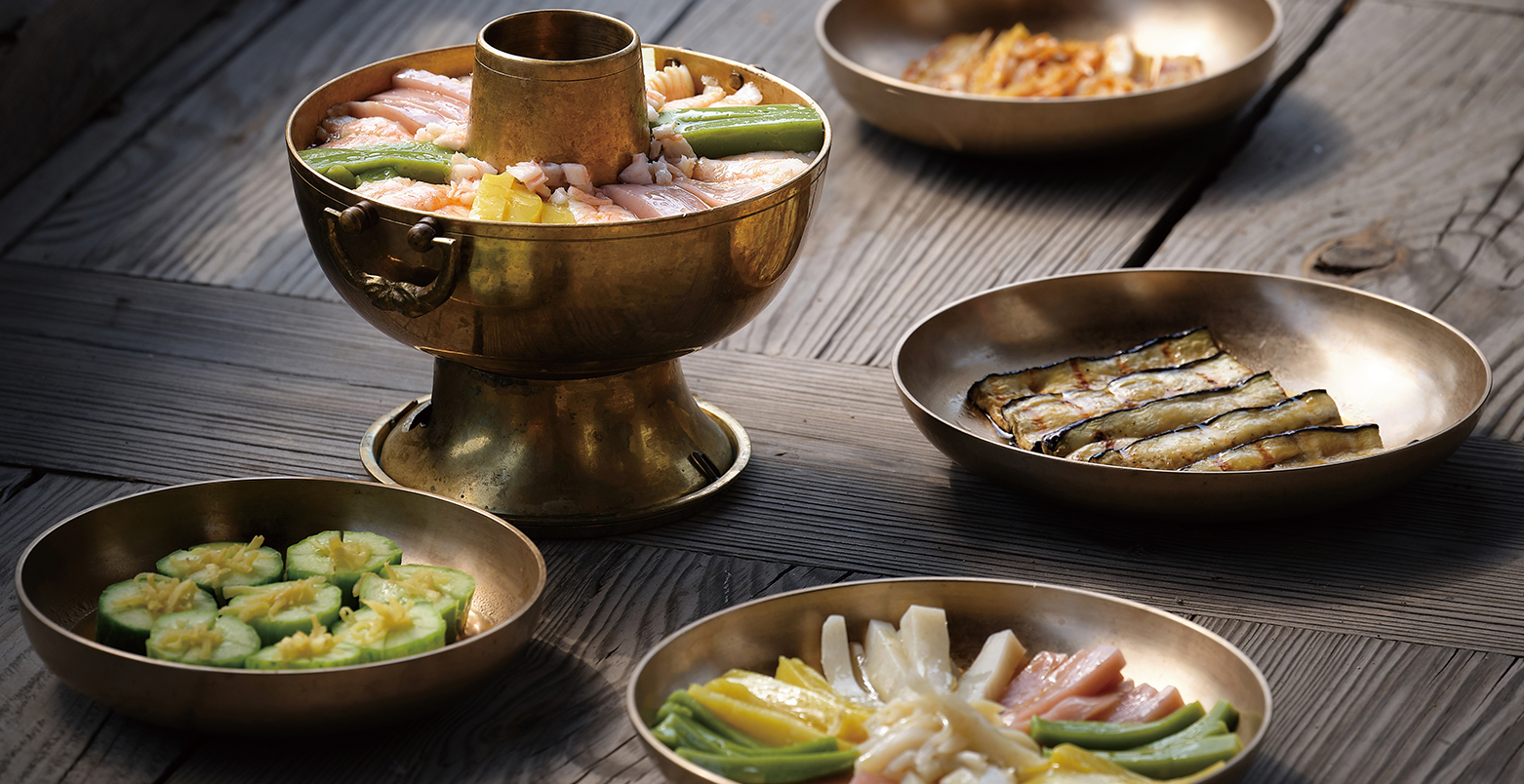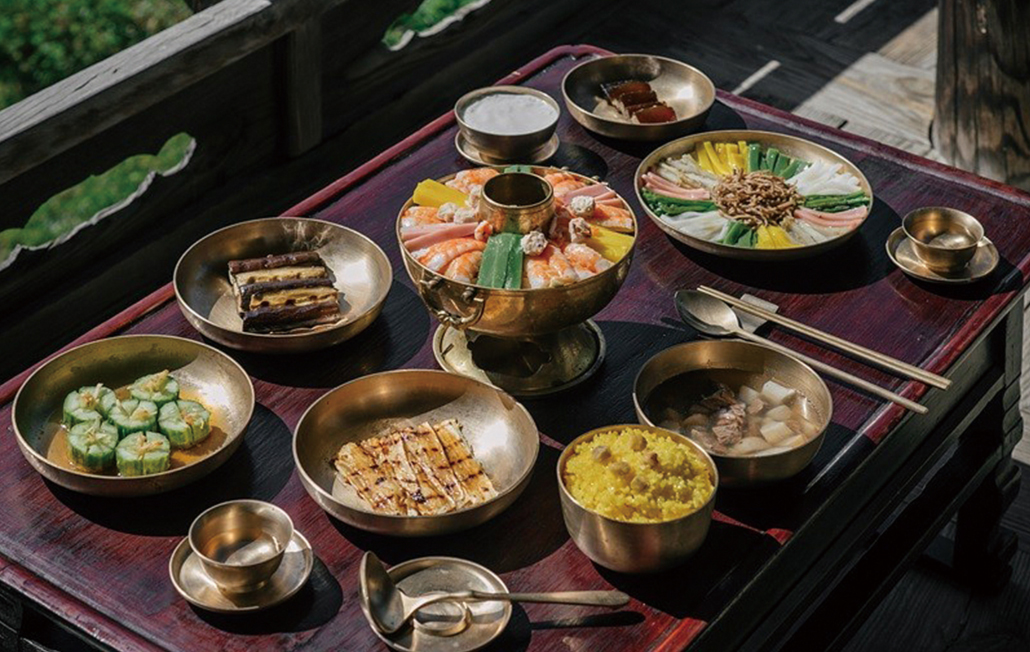
Contents










Local Taste · Written by Korean Food Promotion Institute Photographed by Studio Kenn
Noble Cuisine Passed
Down for 500 Years
Classic “Soowoonjapbang” Meals
Andong, the capital of Gyeongsangbuk-do Province, is the bastion of
Korean Confucian culture where residents live in homes hundreds of years old.
The head houses of clans, filled with immense pride for their ancestors
and lineage, have always considered the proper serving of guests as the greatest virtue.
This belief has thus given birth to gastronomical gems cooked with the utmost care
and sincerity including those from “Soowoonjapbang,” a cookbook more than five centuries old.
Looking at a neatly prepared “Soowoonjapbang” meal often makes diners
feel warmly treated and happy before even tasting it.

Soowoonjapbang” is a cookbook written in the mid-1500s by Kim Yu of the Gwangsan Kim clan during the reign of Joseon Dynasty King Jungjong. The author’s grandson Kim Ryeong carried on this work by adding details to traditional recipes. Comprised of two volumes—the first written by the grandfather and the latter by the grandson—this cultural artifact has been kept at the Seolwoldang head house for over five centuries.
The cookbook, considered the oldest among those surviving in Korea, has meticulous culinary instructions on everything from the use of ingredients to cooking methods, offering a glimpse of the food culture of Andong and vicinity at the time. This invaluable artifact thus provides a detailed source on the food and beverages Koreans consumed in the 1500s.
The book’s 121 recipes cover 17 for kimchi, five for herbs and 59 for liquor, coupled with methods for making noodles and baking confectionary. The text being written in ancient Chinese characters made it difficult to understand, thus its proper translation required extensive academic research. Seoul National University, SungKyunKwan University and Andong National University participated in the translation process, and the Korea Studies Advancement Center in Andong and the head house continue further joint research. Since the translation’s completion, the head family has strived to present the foods in the cookbook to woo today’s diners.
Containing recipes that yangban (aristocrats) served to valued guests, “Soowoonjapbang” took a long time to write as evidenced by its traces of massive efforts in research, thinking, recording and completion of creative dishes to serve guests. For instance, someone who suffered from rhinitis during a change of season was served food containing ingredients good for treating the condition. Each case was recorded thoroughly and if the person visited again, the same dish was served.
Restoration of Tradition
The Soowoonjapbang Research Institute in Andong makes “Soowoonjapbang” meals for guests. This think tank has revived the set tables offered to distinguished guests more than 500 years ago. The foods include hwangbap (rice made of yellow gardenia seeds), seoyeotang (soup with cinnamon vine and beef), samsaekeoatang (soup with sweetfish, shrimp and mung bean jelly), cheongpomuk (mung bean jelly dyed with beautifully colored flower water), buntang (soup with vegetables covered in meat broth), mojeomi (cut and roasted eggplant) and hyanggwajeo (pickled cucumbers decorated with finely sliced ginger).
The restored dishes utilize a variety of ingredients including meat, seafood and vegetables in addition to hoehyang, or fennel seed in Western cuisine, and jeonghyang, a spice used in making pickles. Surprisingly, the table also includes plain yogurt called tarak. Tarak’s difference from today’s yogurt is that the latter uses the probiotic lactobacillus but the former uses rice wine. Jeonyak is a dessert made of edible glue, a major component of collagen, as well as jujube and honey resembling sweet red bean jelly. Yukmyeon, or noodles served with lean beef, is another premium dish not found in other cookbooks.
Three years ago, the high-end Korean restaurant La Yeon at the Shilla Hotel in Seoul presented “Soowoonjapbang” meals with a contemporary flair with Kim Do-eun, the 15th descendant of the Seolwoldang clan of the Gwangsan Kim family. The restaurant received three Michelin stars the same year, and this sparked renewed popularity of “Soowoonjapbang.” Since then, Europeans have also shown keen interest in the cuisine, providing the fruits of Andong and Gyeongsangbuk-do Province’s efforts to preserve and develop this invaluable cultural heritage.
 The “Soowoonjapbang” meal prepared to welcome guests 500 years ago is still available today. © Korean Food Promotion Institute
The “Soowoonjapbang” meal prepared to welcome guests 500 years ago is still available today. © Korean Food Promotion Institute Mojeomi is a cut and roasted eggplant that accentuates the flavor. © Korean Food Promotion Institute
Mojeomi is a cut and roasted eggplant that accentuates the flavor. © Korean Food Promotion InstituteAlways Guests of Honor
“Soowoonjapbang” dishes do not use red pepper powder and instead utilize other spices known as jeonghyang and hoehyang for meat and seafood, respectively. Such dishes also contain ingredients with medicinal effects during the seasons. The dishes restored from 500 years ago boast an unbelievably gorgeous appearance.
The making of samsaekeoatang, a premium dish composed of healthy ingredients with beautiful and fancy colors, requires high devotion to cooking. The scales and skin of a sweetfish or gray mullet are removed, then the fish is sliced and covered in mung bean powder before being boiled in hot water and minced. Mung bean powder, doenjang (fermented soybean paste) and white scallions are added to make round-shaped balls similar to bird eggs. A jumbo shrimp is peeled and cut into two pieces, and is then decorated with three-colored jellies of yellow, pink and green with gardenia seeds, cockscomb flower water and spinach or chives, respectively. Hoehyang is added to the water used to boil the fish, and the soup is seasoned with soy sauce and brought down to a simmer. The round-shaped balls, jumbo shrimp and mung bean jelly are added to the soup to complete the dish.

Cheongpomuk (mung bean jelly) on the cutting board is dyed with beautifully colored flower water.
Cheongpomuk, complete with splendid colors thanks to a variety of vegetables and flower water, brightens up a “Soowoonjapbang” meal. Balloon flower roots and water parsley coated in mung bean powder are steamed. Since old times, the people of Andong have utilized delicious and high-protein mung beans in a variety of foods, as the area is famous for its cultivation of mung beans. Residents typically made porridge with the beans but yangban households cooked more sophisticated dishes with them. The center of a table is ornamented with beef noodles, whose gorgeous harmonious colors is a feast for both the eyes and palate. Paired with the meat broth, Cheongpomuk guarantees a clean and simple taste.
Centuries ago, kimchi went by a different name: jeo. A surefire hit is cucumber kimchi made by seasoning cucumbers prepared the night before with soy sauce and adding a touch of ginger. The crispy and moderately spicy side dish is a great complement to any main dish. Kimchi made with eggplant is called jeupjeo. After rinsing carefully, the eggplant is seasoned with soy sauce, wheat bran and bay salt. Everything from the main plate to side dishes offer a light and clean taste that make jeupjeo an ideal choice to serve guests.
Other Articles















